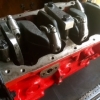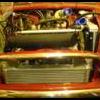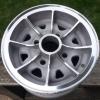It's a great graph, thanks for finding and posting it.
It does show the point that I made in my first post in this thread that with a shorter rod, as the volume of the cylinder is increasing, the piston velocity is higher, leading to better cylinder filling.
There's many good points also raised in that article. One other consideration I was getting around to is that with a longer rod it increases the reciprocating mass.
In respect of our A Series Engines and the heads they have, a very good point is raised here in that article;-
"So this longer rod, higher rod:stroke ratio seems awesome. Why aren't all engines built this way? Well, not all engines are race engines that only operate in the upper rpm range. The lower piston acceleration that benefits volumetric efficiency at higher rpms can hurt it at lower rpms. The port velocity can become too low in the lower rpm range reducing exhaust scavenging effects thereby hurting volumetric efficiency resulting in gutless bottom end torque. This does not make for a very good daily driver stuck in stop and go traffic. As the saying goes, there's no free lunch! Also, just like when designing intake manifolds, exhaust manifolds, and cams, optimizing for one part of the rev band generally hurts the opposite end. But what we learned is that the rod:stroke ratio is another variable that can be optimized to improve performance."
Our engine simply cannot rev in to the range where the rods we have can work best for a few reasons, not the least of which is the asthmatic cylinder heads they have. A better head can be fitted but as the A Series Engine (except for the 970) is under-square, the limitation with any head that's going to be fitted is that the valves (and therefore ports) will always be well less than optimal than for a square or over square engine.
Higher Rod Ratios are used in short stroke very high reving engines, neither of which is applicable to the A Series Engine.
Again, from that great article that mini13 kindly posted up;-
"The Yamaha YZF R1 is a typical modern sports bike that revs to 12,000 rpm. Its engine has a stroke to rod length ratio of 2.12:1 which is suitable for high rpm use. This can be compared to a Nissan SR20DE engine which revs to 7700 RPM with a rod to stroke length ratio of 1.58:1"
By running a short rod and therefore increasing peak piston velocity further down the bore, we can take best advantage of the limited flow we have. Instead of trying to grab a big amount of air in a short space of time, we are drawing a bigger amount over a longer period.and as the volume is increasing, so the piston velocity is increasing at a better rate than with longer rods.
<EDIT: Stroke length has a much greater effect on any TDC Dwell time than Rod Length will. >
Edited by Moke Spider, 26 April 2017 - 07:22 PM.

















